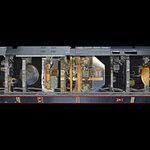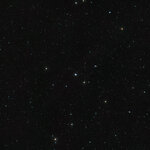Space
The NASA STEREO mission (my mission!) is visiting L4 and L5. These are the Lagrange points are where the Earth and Sun gravitationally balance each other out. SOHO hangs out at L1, between Earth and Sun (but very near Earth). L4 and L5 are about 60 degrees ahead and behind the Earth's position in its orbit.
Since L4/L5 gather material, we expect more dust. Dust, of course, can damage our detectors should there be a significant fluke hit directly on a camera. Already, we 'see'-- as in, get hit by-- regions of dust in Earth's orbit. STEREO B suffers more than its sibling A, as B's…

A research team say they have found a sample of massive galaxies with properties that suggest that they may have formed relatively recently, which runs counter to the widely-held belief that massive, luminous galaxies (like our own Milky Way) began their formation and evolution shortly after the Big Bang, some 13 billion years ago. Further research into the nature of these objects could open new windows into the study of the origin and early evolution of galaxies.
John Salzer, principal investigator for the study published today in Astrophysical Journal Letters, said that the 15…

Where does space begin? Scientists at the University of Calgary have created a new instrument that is able to track the transition between the relatively gentle winds of Earth's atmosphere and the more violent flows of charged particles in space – flows that can reach speeds well over 1000 km/hr. And they have accomplished this in unprecedented detail.
Data received from the U of C-designed instrument sent to space on a NASA launch from Alaska about two years ago was able to help pinpoint the so-called edge of space: the boundary between the Earth's atmosphere and outer space.
With that…
The International Year of Astronomy continues its celebration with a photo of triple galaxy group April 1 and 2. 140,000 people around the world voted on six potential targets; the Arp 274 galaxy group won with 67,000 votes.
For some reason I really want a Milky Way Dairy Queen Blizzard... Thanks to Wired for the photo and the following description.
Hubble's image suggests the galaxies may not be close enough together to interact as they appear to be in the image taken by the Palomar Observatory near San Diego.
The galaxies to the right and left show blueish lights, evidence of…

On March 17th 2009 Europe's first geodetic satellite was successfully launched from the Plesetsk Cosmodrome in Russia. The first stages of putting the satellite in a stable recording orbit are proceeding according to plans. So far, so good.
Credit: ESA - AOES Medialab
I feel a little bad withholding this terrific news from the European Space Agency. It is wonderful news for the international geodetic community as a whole. In fact, it is good news for all of us. GOCE will collect data that after thorough analysis will improve our knowledge about ocean circulation, sea level and provide us…
Galileo Galilei Linceo was, among other talents, a solar physicist. While not the first to observe sunspots, he sketched (in 1612) some of the earliest surviving tracings of sunspots. Observing their daily motion, he deduced that a) they were on or near the surface of the sun and b) that the sun was rotating.
Here is an animated GIF of the sunspots highlighting the sun's rotation. This is built from scans of his drawings archived at galileo.rice.edu. Writes Edward Tufte on Ask E.T.: "... That website (by Albert Van Helden and Elizabeth Burr) on Galileo is superb, a model for a teaching and…

A new Hubble image highlights striking swirling dust lanes and glittering globular clusters in oddball galaxy NGC 7049.
The NASA/ESA's Hubble Space Telescope has captured this image of NGC 7049, a mysterious looking galaxy on the border between spiral and elliptical galaxies. NGC 7049 is found in the constellation of Indus, and is the brightest of a cluster of galaxies, a so-called Brightest Cluster Galaxy (BCG). Typical BCGs are some of the oldest and most massive galaxies. They provide excellent opportunities for astronomers to study the elusive globular clusters lurking within.
The…

As part of the International Year of Astronomy 2009 Cornerstone project, 100 Hours of Astronomy, the ambitious “Around the World in 80 Telescopes” event is a unique live webcast over 24 hours, following night and day around the globe to some of the most advanced observatories on and off the planet.
To provide a long-lasting memory of this amazing world tour, observatories worldwide are revealing wonderful, and previously unseen, astronomical images. For its part, ESO is releasing outstanding pictures of two galaxies, observed with telescopes at the La Silla and Paranal observatories. …

A small, dense object only twelve miles in diameter is responsible for this beautiful X-ray nebula that spans 150 light years. At the center of this image made by NASA's Chandra X-ray Observatory is a very young and powerful pulsar, known as PSR B1509-58, or B1509 for short.
The pulsar is a rapidly spinning neutron star which is spewing energy out into the space around it to create complex and intriguing structures, including one that resembles a large cosmic hand. In this image, the lowest energy X-rays that Chandra detects are red, the medium range is green, and the most energetic ones are…

While the team here discusses our current veeery quiet solar minimum, what are working solar physicists thinking? Well, from the SPA Newsletter (http://spc.igpp.ucla.edu/spa/spanews.html), a twice-weekly newsletter, came this neat bit of April 1 whimsy:Solar Dynamics Observer Mission Postponed
---------------------------------------------------------------------------
From: Officials of NASA Heliosfearic Division today reluctantly announced the postponement of the launch of the Solar Dynamics Observer until such a time as the Sun becomes dynamic again. The head of the Division, Rich…